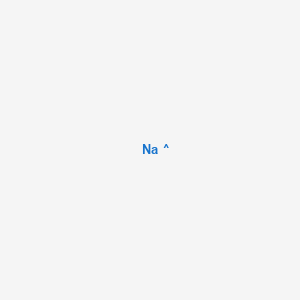D0112 | Sodium
A
A12CA Sodium
[A12C] OTHER MINERAL SUPPLEMENTS
[A12] MINERAL SUPPLEMENTS
[A] Alimentary tract and metabolism
[]
| Pictogram | Signal | Statements | Precautionary Statement Codes |
|---|---|---|---|
  |
Danger |
H260: In contact with water releases flammable gases which may ignite spontaneously [Danger Substances and mixtures which in contact with water, emit flammable gases] H314: Causes severe skin burns and eye damage [Danger Skin corrosion/irritation] |
P223, P231+P232, P260, P264, P280, P301+P330+P331, P303+P361+P353, P304+P340, P305+P351+P338, P310, P321, P335+P334, P363, P370+P378, P402+P404, P405, and P501; (The corresponding statement to each P-code can be found at the GHS Classification page.) |
  |
Danger |
Aggregated GHS information provided by 421 companies from 7 notifications to the ECHA C&L Inventory. Each notification may be associated with multiple companies. H260 (100%): In contact with water releases flammable gases which may ignite spontaneously [Danger Substances and mixtures which in contact with water, emit flammable gases] H314 (100%): Causes severe skin burns and eye damage [Danger Skin corrosion/irritation] H318 (21.38%): Causes serious eye damage [Danger Serious eye damage/eye irritation] Information may vary between notifications depending on impurities, additives, and other factors. The percentage value in parenthesis indicates the notified classification ratio from companies that provide hazard codes. Only hazard codes with percentage values above 10% are shown. |
P223, P231+P232, P260, P264, P280, P301+P330+P331, P303+P361+P353, P304+P340, P305+P351+P338, P310, P321, P335+P334, P363, P370+P378, P402+P404, P405, and P501; (The corresponding statement to each P-code can be found at the GHS Classification page.) |
  |
Danger |
H260: In contact with water releases flammable gases which may ignite spontaneously [Danger Substances and mixtures which in contact with water, emit flammable gases] H314: Causes severe skin burns and eye damage [Danger Skin corrosion/irritation] |
P223, P231+P232, P260, P264, P280, P301+P330+P331, P303+P361+P353, P304+P340, P305+P351+P338, P310, P321, P335+P334, P363, P370+P378, P402+P404, P405, and P501; (The corresponding statement to each P-code can be found at the GHS Classification page.) |
  |
Danger |
H260: In contact with water releases flammable gases which may ignite spontaneously [Danger Substances and mixtures which in contact with water, emit flammable gases] H314: Causes severe skin burns and eye damage [Danger Skin corrosion/irritation] H318: Causes serious eye damage [Danger Serious eye damage/eye irritation] |
P223, P231+P232, P260, P264, P280, P301+P330+P331, P303+P361+P353, P304+P340, P305+P351+P338, P310, P321, P335+P334, P363, P370+P378, P402+P404, P405, and P501; (The corresponding statement to each P-code can be found at the GHS Classification page.) |
| Organism | Test type | Route | Dose (normalized dose) | Effect | Source |
|---|---|---|---|---|---|
| rat | LD50 | oral | 9690mg/kg (9690mg/kg) | Farmakologiya i Toksikologiya Vol. 43, Pg. 714, 1980. | |
| rat | LD50 | intraperitoneal | 1650mg/kg (1650mg/kg) | Therapie. Vol. 32, Pg. 375, 1977. | |
| man | TDLo | oral | 71mg/kg (71mg/kg) | American Journal of Emergency Medicine. Vol. 9, Pg. 321, 1991. | |
| mouse | LD50 | intraperitoneal | 3300mg/kg (3300mg/kg) | Japanese Journal of Pharmacology. Vol. 17, Pg. 30, 1967. | |
| 11Na | 7440-23-5 | 9NEZ333N27 |
| A838715 | AB01566864_01 | ACMC-1BKTZ |
| AKOS015833457 | ANW-56400 | CHEBI:26708 |
| CTK2H7876 | DTXSID1049774 | EC 231-132-9 |
| EC 231-587-3 | EINECS 231-132-9 | EINECS 231-587-3 |
| FT-0689077 | HSDB 687 | HSDB 745 |
| KEAYESYHFKHZAL-UHFFFAOYSA-N | KS-00001935 | LS-145497 |
| LS-190862 | MFCD00085307 | NAH 80 |
| Na | Natrium | RT-000087 |
| SC-91613 | SODIUM, LARGE PIECES | Sodio |
| Sodio [Spanish] | Sodium | Sodium (liquid alloy) |
| Sodium Phyllo-pentaoxodimanganate(III) | Sodium [UN1428] [Dangerous when wet] | Sodium [UN1428] [Dangerous when wet] |
| Sodium hydride (in oil dispersion) 60% dispersion in mineral oil | Sodium hydride [UN1427] [Dangerous when wet] | Sodium hydride, 57-63% oil dispersion |
| Sodium hydride, 60 % dispersion in mineral oil | Sodium hydride, CP | Sodium hydride, dry, 95% |
| Sodium hydride, powder (moistened with oil), in soluble SecuBags(R), 55-65% (gas-volumetric) | Sodium metal | Sodium standard for AAS, analytical standard, 10.00 g/L Na in nitric acid |
| Sodium standard for AAS, ready-to-use, in nitric acid | Sodium standard for ICP, for ICP, ready-to-use, in nitric acid | Sodium, 25-35 wt % dispersion in paraffin |
| Sodium, 30wt% dispersion in toluene, <0.1 mm particle size | Sodium, 40 wt % dispersion in paraffin | Sodium, 99%, lumps, contains kerosene |
| Sodium, 99.8%, oiled sticks, wrapped in aluminium foil | Sodium, 99.95% trace metals basis, ingot | Sodium, ACS reagent, dry |
| Sodium, CP | Sodium, Ion chromatography standard solution, Specpure, Na+ 1000g/ml | Sodium, Oil based standard solution, Specpure, Na 5000g/g |
| Sodium, Oil based standard solution, Specpure?, Na 1000?g/g | Sodium, SAJ first grade, >=99.5% | Sodium, cubes, contains mineral oil, 99.9% trace metals basis |
| Sodium, dry stick | Sodium, in kerosene, pieces (large), >=99.8% (sodium basis) | Sodium-23 |
| TRA-0177117 | UN1427 | UN1428 |
| UNII-23J3BHR95O | UNII-9NEZ333N27 | mono sodium |
| mono-sodium | monosodium | sodium atom |
| CAS Number | 1069-66-5, 116001-96-8, 13392-69-3, 2386-53-0, 36175-05-0, 502-85-2, 52286-11-0, 7440-23-5, 7646-69-7, 990-73-8 |
| PubChem Compound | 5360545 |
| KEGG Compound ID | C01330(Na+) |
| ChEBI | 26708 |
| ChemSpider | 4514534 |

